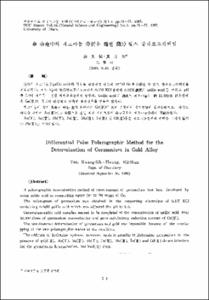울산만내의 2차원 분산현상에 관한 연구
- Alternative Title
- A Numerical Simulation Study of Two Dimensional Dispersion Problem in Ulsan Bay
- Abstract
- 해양 오염 문제의 효과적인 대처방안은 오염물질의 분산현상을 규명함으로써 오염원에 의한 시간적, 공간적 농도분포를 예측하고 이들 오염원에 의한 피해가 없도록 관리하는 것이다. 울산만은 평균 대조차 48.2㎝의 조석과 태화강 유입수에 의한 해수유동이 발생하고 있어 이에따른 오염물질의 분산현상을 파악하여야 한다.
본 논문에서는 해수유동 현상은 Navier - Stokes 방정식을 유한차분 양해법으로 구한 Christopher G. Koutitas(1988)의 모델을 사용하였고, 여기서 계산된 해수유동 속도를 사용하여 수심방향으로 적분된 2차원 분산방정식을 2차의 삼각형요소를 사용한 유한요소법에 의해 해석하였다.
계산결과를 측정치와 비교 검정을 하지는 않았으나 하구만에서의 분산에 관한 정성적 현상을 파악하는데는 크게 유용하게 활용될 것으로 생각된다.
An effective counterplan of sea pollution problem is preestimating the concentration distribution depending on time and place through finding out the dispersion phenomena of pollutants, and managing not to be damaged by such pollutants.
There are 48.2 ㎝ of mean spring tide and outflow of Taewha river in Ulsan Bay, so the dispersion phenomena should be calculated according to these conditions.
In this paper the flow problem of sea area was calculated using the Christoper G. Koutitas finite difference model in solving Navier-Stokes equation, and using these velocity results the two dimensional dispersion equation which is integrated according to depth was calculated using the finite element method of quadratic triangular elements.
The calculated results was not verified comparing to observed data but this results should be very useful in practical dispersion problems qualitatively in the area of estuaries.
An effective counterplan of sea pollution problem is preestimating the concentration distribution depending on time and place through finding out the dispersion phenomena of pollutants, and managing not to be damaged by such pollutants.
There are 48.2 ㎝ of mean spring tide and outflow of Taewha river in Ulsan Bay, so the dispersion phenomena should be calculated according to these conditions.
In this paper the flow problem of sea area was calculated using the Christoper G. Koutitas finite difference model in solving Navier-Stokes equation, and using these velocity results the two dimensional dispersion equation which is integrated according to depth was calculated using the finite element method of quadratic triangular elements.
The calculated results was not verified comparing to observed data but this results should be very useful in practical dispersion problems qualitatively in the area of estuaries.
- Issued Date
- 1998
- Type
- Research Laboratory
- Alternative Author(s)
- Kim, Seong-deuk; Kou, Seong-hun
- Publisher
- 공학연구논문집
- Language
- kor
- Rights
- 울산대학교 저작물은 저작권에 의해 보호받습니다.
- Citation Volume
- 29
- Citation Number
- 2
- Citation Start Page
- 179
- Citation End Page
- 190
- Appears in Collections:
- Research Laboratory > Engineering Research
- 파일 목록
-
-
Download
 000002023959.pdf
기타 데이터 / 238.47 kB / Adobe PDF
000002023959.pdf
기타 데이터 / 238.47 kB / Adobe PDF
-
Items in Repository are protected by copyright, with all rights reserved, unless otherwise indicated.